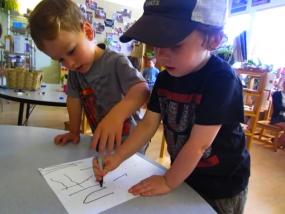The Challenge of Printing Ns

This video captures two pre-kindergarten friends, both named Finn, explaining strategies for writing their names to one another. Finn P. is on the right in the dark shirt; Finn Q. is on the left and has 95 printed on his T-shirt. These children have been in class together since infancy. It is clear that they are very comfortable and trust each other, enough to open themselves up to debate and to receive/offer feedback. Finn P.'s mother taught him a strategy for writing “N ” – “up the ladder, down the slide, up the ladder”. These words guide him to start the first stroke of the “N” at the bottom, rather than at the top and stroking down as most children do. Starting at the top yields an inverted diagonal because young children do not lift and relocate their marker once they start (see Jacqueline Goodnow's book, Children Drawing). Now let’s look at the interesting problems that occur as together they work through the process of printing F I N N. Finn P. recites the ladder/slide words, but ends with "down the slide" (00:11). He needs one more "up the ladder” to complete the second “N”. The double “N”s are complicated by the fact that the right side of the first “N” is shared by the left side of the second “N”. Finn Q. begins with the letter “F” but is too close to the left side of the paper. He skips the “I”, adds the “N”, and puts the “I” in front of the “F”. Writing requires planning the use of available space. We don't think he has forgotten the proper sequence; he has simply run out of room. But let’s see what he does later. Also, notice that Finn Q.'s letter “N” has the inverted diagonal because he starts the first stroke at the top. (00:25). Finn P. knows that Finn Q. did not say the ladder/slide words. We are not sure if he sees the inverted diagonal in his friend's “N”. But we do see Finn P. give his friend another lesson on how to make a proper “N”. "That's it," he says (00:42). Finn Q. adds a “P” on the paper where space is available, knowing to distinguish one Finn from the other. Finn P. recognizes the incompleteness in his friend's “P” and asks the teacher for help. In the next segment, Finn P. once again begins with his verbal guide to making the letter “N”, but at some point he shifts from spelling his name to demonstrating the verbal guide. He keeps going, making a row of connected “N”s, about six of them. But in the process his "up the ladder" is spoken when he is stroking down, and the "down the slide" is spoken when he is stroking up (01:10). Is this just a lapse of attention or does he not understand the meaning of the phrases? This is hard to know. But he does seem to adjust his actions to his words toward the end of his row of connected “N”s. Of course, when he learns to separate the shared stem of adjacent “N”s, some of these problems will disappear. As his row becomes more of a series of peaks, it is hard to tell which marks are the vertical strokes and which marks are meant to be the diagonal. And you will see later, when Finn Q. carefully traces the marks "up the ladder" and "down the slide"(02:18) that no one is concerned that the "ladders" are no longer vertical, as the stems of the letter “N” should be. So what do the phrases mean to either child? Finn Q. looks at the row of peaks and calmly says, "That's not your name," perhaps meaning "Those marks do not look like the marks I remember as spelling F I N N. " Finn Q, tries to write F I N N for his friend, makes the letter “F”, but then makes two “N”s with inverted diagonals joined as a continuous mark. Finn P. coaches Finn Q. to say "up the ladder," but it is too late. Finn Q. has already started the “N” at the top and drags his marker down. So Finn P. waits until Finn Q. moves his marker up on the inverted diagonal. Then Finn P. says "up the ladder," not caring that the diagonal is supposed to be the slide, not the ladder (02:58). We can reason that the directions up and down have utility for Finn P., but the difference between a ladder and a slide does not. Even so, when Finn Q. is done, Finn P. realizes the result does not match his memory. "That's not my name (03:12). You will learn by watching the rest of this video that Finn Q. cannot verbalize what is wrong with Finn P.'s row of peaks or his own first try. His only recourse is to try again to write FINN P correctly, which he does by the end of the video. So we might ask, "where" does his knowledge reside? We might venture to say it does not reside in a remembered set of verbal rules that would allow him to say something like, "You left out the ‘P’ and the ‘I’" or " You have too many ‘N’s." His knowledge resides in his action memory of writing the letters himself. But then how does he recognize that the row of peaks is wrong? This too comes from something less than a set of verbal rules. He simply does not recognize the row of peaks as a match to his, shall we say, mental picture of FINN. Such is the path of learning to write. Only gradually do children treat writing as a set of encoded rules. Herein lies the controversy of when to teach children to write. What do you think? Keywords: Fours, Child-Child, Writing, Spelling, Literacy Length of video: 4 minutes 33 seconds
